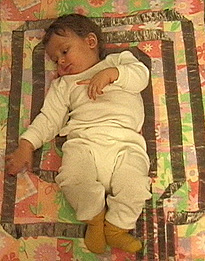|
|
Developed by Gil Weinberg,
Rich Fletcher and Seum-Lim
Gan the BabySense Environment
is designed to enhance an infant's sensory-motor
experience, to allow parents and relatives to remotely
monitor infant’s development, and to enable new
types of interactions with other infants. The system also
demonstrates alternate peripheral means of displaying
information such as lights, sound and a kinetic
sculpture. |
 The
BabySense System
|
| |
|
|
| |
Sensing - The sensor pad is a comfortable soft foam pad
which can sense the baby’s presence and motion. The
foam pad contains regions of electrically conductive
fabric that form electrodes. Sensing is done by
monitoring changes in the capacitance of the fabric
electrodes [5]. Both the presence of a human body and
pressure on the fabric will produce detectable signals.
These signals can be used to detect limb movement and
other patterns of behavior like sitting up, standing up,
playing with toys etc.
Local Display
- The local output device or
“display” is a mobile sculpture object that
hangs above the baby’s crib. At present, the local
display shows data in the form of lights and sound in
response to the baby’s movements. Controlling the
motion of parts of the mobile are also possible as an
additional means of displaying information.
|
 A Baby on
the internal side
of the sensing pad
|
| |
|
|
| |
Remote Display - The remote display enables parents to monitor
their baby's activity from a remote location, whenever
local monitoring is not possible. It also enables the
possibility for distant people (e.g. grandmother or
parent at work) to monitor the baby’s activity and
perhaps participate in the baby's physical and cognition
progress. Devices for
remotely displaying the BabySense information can
be in the form of either a foreground or background
remote displays. A foreground display device is one that
directly and obviously displays the data. Alternatively,
a background display is more subtle and provides
peripheral information, thus enabling the user to focus
on other ongoing tasks.
The foreground remote display we have
selected is a small (hand-size) toy panda bear. The toy
contains embedded colored lights and a small audio
speaker which are activated in a controlled manner in
response to the baby’s movements and development. As
the baby grows, the patterns of lights evolve to reflect
the baby’s development. As an example of a
background display, we chose a kinetic sculpture which is
compatible with other decorative objects used on an
office desk or on a grandmother’s night table.
|

A grandmother monitors
baby's behavior
|
| |
|
|
| |
Interaction
- The BabySense also
incorporates an interaction mode where infants can
interact with a friend in a remote place via special
wireless interconnected toys. In addition to serving as a
remote display, these special toys will employ
kinesthetic interaction. For example, when the baby
nudges the toy in his crib, it can cause the toy in the
other baby’s crib to wiggle. Second baby’s
response will also be transmitted back to first, which
creates an interactive circle between two infants sitting
across from each other in adjacent cribs. |
 2 babies interact with musical disks
|




